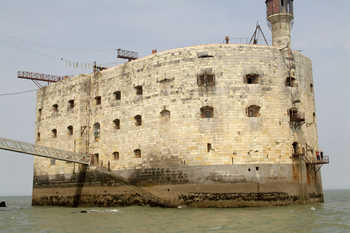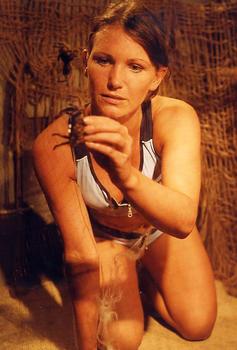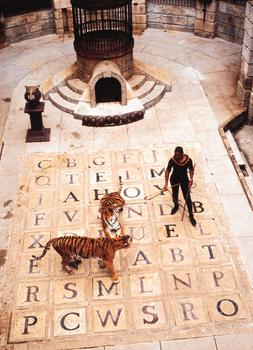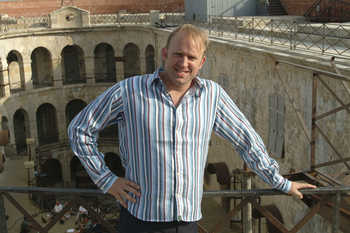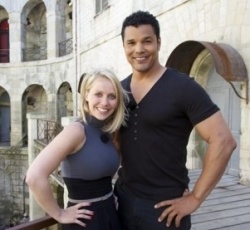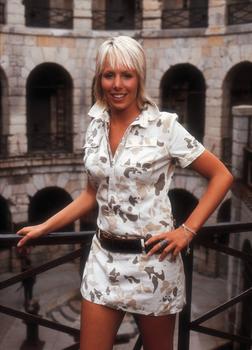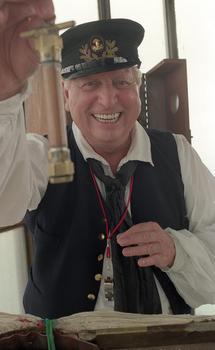Fort Boyard
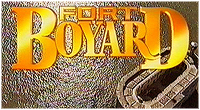
Contents[hide] |
Host
Richard O'Brien (non-broadcast pilot)
Melinda Messenger (1998-2001)
Jodie Penfold (2003)
Takes on the World: Tim Vine (2004)
Ultimate Challenge:
Laura Hamilton (all series)
Geno Segers (Series 1-2)
Andy Akinwolere (Series 3-5)
Co-hosts
1998-2001:
Leslie Grantham (Boyard, master of the Fort)
Geoffrey Bayldon (the old professor)
2003:
Christopher Ellison (Boyard)
Tom Baker (Captain)
Broadcast
Grundy (a Pearson Television Company) for Channel 5, 16 October 1998 to 27 July 2001 (40 episodes in 3 series)
Thames (a Fremantle company) for Channel 5, 22 September to 29 December 2001 (14 episodes in 1 series)
Adventure Line Productions in collaboration with Ronin Entertainment for Challenge, 20 October to 3 December 2003 (20 episodes in 1 series)
Fort Boyard takes on the World:
Challenge, 18 to 29 October 2004 (10 episodes in 1 series)
Fort Boyard: Ultimate Challenge:
The Foundation and Adventure Line Productions for CITV, 1 January 2012 to 17 December 2014 (50 episodes in 5 series)
Synopsis
Brilliant, brilliant, brilliant superb show. Very few other shows matched it in terms of style, excitement and cleverness. Including, sadly, the British version of this original French smash hit.
Whereas most UK game shows would be happy to site themselves in a studio set or outdoor location, the French - being French - decide to install miles of wiring and cameras into a national monument so that we can laugh at women getting covered in mud and men being chased by tigers. Genius!
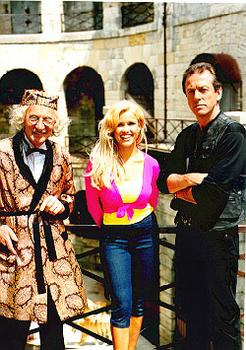 The Professor (Geoffrey Bayldon), Melinda Messenger, and the evil Boyard, master of the fort (Leslie Grantham).
The Professor (Geoffrey Bayldon), Melinda Messenger, and the evil Boyard, master of the fort (Leslie Grantham).The programme was based in a real Napoleonic fort off the west coast of France, which was an almost immediate white elephant when it was built because the Napoleonic wars ended before it was completed. It was turned into a TV studio for the original French programme.
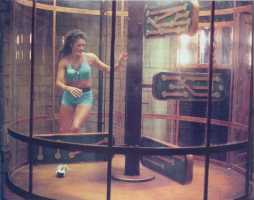 In this game, the contestant had to "run ahead" of the rotating panels to give herself enough time to unscrew the bolts on the box containing the key, before a wire fence forced her to make another journey.
In this game, the contestant had to "run ahead" of the rotating panels to give herself enough time to unscrew the bolts on the box containing the key, before a wire fence forced her to make another journey.The Game
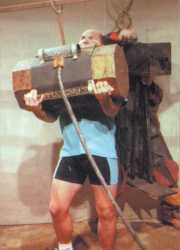 This contestant must win the key by carrying the vibrating cabinet across the room without letting the ring at the top touch the wire.
This contestant must win the key by carrying the vibrating cabinet across the room without letting the ring at the top touch the wire.The game mechanics were that the team had 40 minutes to earn four keys to open the door by beating timed challenges and answering riddles (so far, so The Crystal Maze) and then earning clues to a codeword by playing games that played on people's fears.
Fight the fear
The games used in the "getting the keys" section of the programme were fairly straightforward, even if they took a lot of physical strength or dexterity to complete.
However, it was the codeword games later in the programme that got a lot of the attention. These games were based on common psychological fears - such as the dark, heights, insects, snakes, spiders, water, bungee jumping and so on.
A lot of the show's black humour was taken out in the original British incarnation of this format, The Crystal Maze, to be replaced by more cerebral games.
Going for the gold
At the end of the time, they went into the treasure room, spelled out the password on the floor and if they were correct, they had the rest of the two minutes to get as many "gold doubloons" as they can. We were never told how much a doubloon was worth, merely that they would "convert the gold into cash later". Hmm... Thankfully, they were a bit more honest about it in later series, and now the gold score was converted into a leaderboard-style effort which worked a lot better.
It's not that the British version was bad, it wasn't, it was still a highly engrossing show. But having seen the French version for a number of years you can't help but watch it and think: "They do that bit so much better in France."
Always up for a Challenge
Surprising many, Challenge created their own version of the show during the Summer of 2003. Even more surprising considering the budgetary constraints they were probably under, they did a really good job. There was more emphasis on collecting keys (teams now have to collect five and are given nine chances to do this) and only two adventures during an episode (but having been off the screens for several years, there was a bank of new adventures to choose from). They had updated the graphics to match more recent French episodes.
Ellison was a far less unfriendly Boyard who resorted to the same speech patterns before each game (this annoyed many fans of Grantham, who at this point had returned to Eastenders, which is reasonable enough). Penfold turned out to be a lot of fun as the main host and Tom Baker was ace as the 19th century marooned captain who was liable to silly monologues.
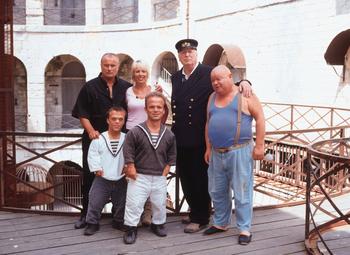 Christopher Ellison, Jodie Penfold and Tom Baker set the challenge with Jacques, Jules and Laboulle.
Christopher Ellison, Jodie Penfold and Tom Baker set the challenge with Jacques, Jules and Laboulle.Takes On The World
We feel this is the best place to include a bit on Fort Boyard: Takes On The World. This was a ten-part entertainment documentary looking at various different versions of the show from around the world. Tim Vine provides a hilarious voiceover for the clips and provides links on location on the Fort. Vine should know what he's talking about, he was a celebrity contestant on Challenge's version of the show in 2003.
Its factually accurate (in the main) and it's particularly pleasing in that it opens up the French version to a British audience. We also particularly enjoy the clips from the Korean show which looks like it's a lot of fun. Regular bits include "The Good, The Bad and The Ugly", "Heroes and Zeroes" (which is a bit like The Good, The Bad and The Ugly, all told), The A-Z of Fort Boyard, seeing how different countries handle the same game and interviews with various characters from the fort (the humour here coming from the fact that Vine doesn't speak French and the characters don't speak English).
Are you ready for the Ultimate Challenge?
In 2012, Fort Boyard made a miraculous return to telly, under the name "Fort Boyard: Ultimate Challenge" and with a totally different format. This version consisted a battle between two teams of 4 players with children aged 13 -18.
The usual games are still present, both teams play 3 head-to-head races, and more games just for them, each key meaning more time in the treasure room. The treasure room format has also changed, both teams now go in but the more keys earned means the more time in the room. Instead of spelling out a codeword, both teams must search the treasure room for their team's crest which they place on the correct symbols on the floor, only then can they collect the gold coins. Whichever teams collect the most gold in their three heats return for the grand final challenge.
Catchphrases
"Jacques, the door!"
"Monique - the tiger's head if you please!"
"Laboulle - the gong!"
From Takes On The World: "Different people, different nations, DIFFERENT GAMES!" (and various variations of)
Inventor
Fort Boyard was the brainchild of Jacques Antoine.
Theme music
The catchy theme tune was the same as the original French programme. It was created by Paul Koulak and Expand Music.
The "Ultimate Challenge" version was created by Paul Farrer.
Trivia
Before Channel 5 got their hands on it, Channel 4 mounted a pilot with Richard O'Brien at the helm. After seeing the pilot, Channel 4 executives insisted that they couldn't show the mud-wrestling game, or the one where a male competitor feels up female mannequins in the dark searching for a real human body. Channel 4 and Chatsworth decided to go in a slightly different direction, taking us on a pleasant journey to The Crystal Maze.
Similar taste and decency problems bedevilled the show ten years later. Channel 5 got in trouble when they used a game from the French show which involved the contestant finding a painted topless lady at the end of a maze then looking for the password that had been 'tattooed' onto her skin. The channel said that it wasn't inappropriate given the late-ish 8pm time slot and that the woman was largely covered up by the paint. But they didn't have much of a leg to stand on when Ofcom noticed that they blurred out the offending nipples on the morning repeat later in the week.
Channel 5 had to film all ten episodes of the first series in five days. Each episode cost about £175,000 to make.
Who were those midgets that went around with the team? Well, in France they are known as Passe-Partout (Everywhere) and Passe-Temps (All the time). They are in every version of the show around the world doing the jobs of contestant coordination, counting the keys and so on. Their real names are Andre and Alain respectively, and when not filming Fort Boyard they are civil servants. They have been with the show since it started in France in 1990.
There was a change of production imprint for Channel 5's final series, when Pearson Television (owners of Grundy Television) were bought by Fremantle. The 2001 series was made by Thames Television, already a subsidiary of Fremantle. Quite reasonably, this backroom change didn't affect the game at all, but it did change the programme's timeslot from its 8pm Friday night slot to Saturday nights.
The first two series of the CITV revival were a joint commission with United States' Disney XD, subsequent series were solely commissioned by CITV.
Merchandise
PC game - similar in style to Tomb Raider
Web links
Comprehensive history of the show
Fort Boyard Net - a French fan site
British Fort Boyard chronicle by Nick Gates
Canadian TV version
Pictures
 Another picture of the fort. The watchtower you can see sticking out from the top is where the Professor set his riddles.
Another picture of the fort. The watchtower you can see sticking out from the top is where the Professor set his riddles.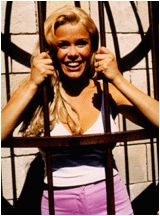 Melinda in jail.
Melinda in jail.Videos
The fort gets taken on for the very first time.
See also
Weaver's Week reviews of Challenge and CITV versions.

